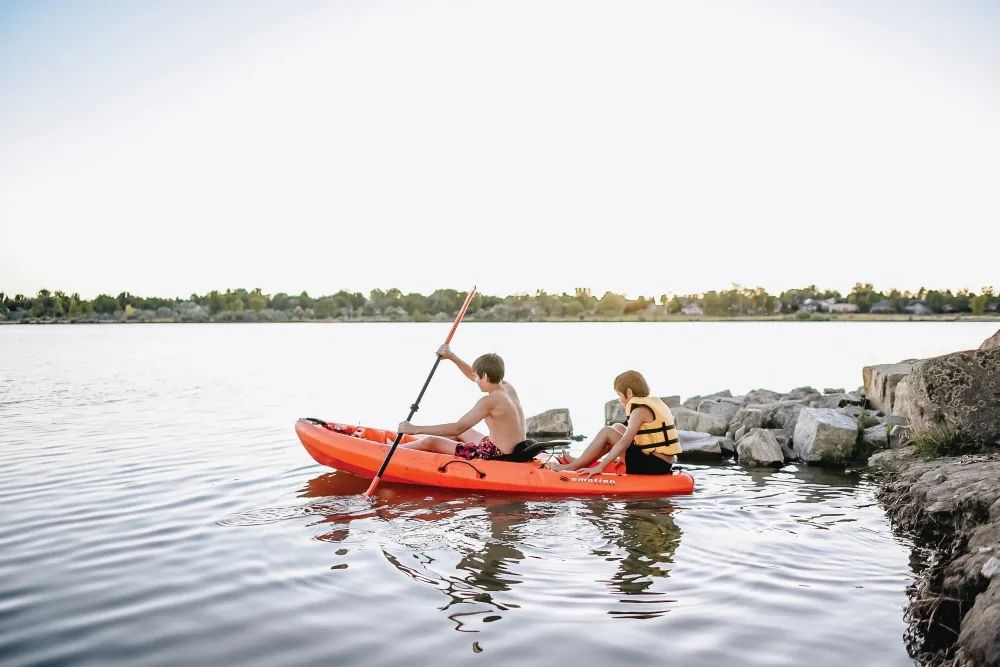
Water Wisdom: Safeguarding Lives at Every Depth
April 2024
article by rebecca stewart | photo by Maighen Kaye Photographer
Water. It’s essential for all living beings; we drink it, bathe in it, play in it, work in it and with it. Perhaps we take it for granted and forget the power of it. As a parent, being vigilant around water – at every depth – is imperative, as drowning is the leading cause of injury-related/accidental death for children ages 1-4. It’s worth noting that, according to the National Safety Council, drowning also continues to be the second leading cause of preventable death through age 15. Additionally, Safe Kids Nationwide reports that children under the age of 1 are more likely to drown at home in the bathtub or a bucket (https://www.safekids.org/watersafety). And, finally, let’s not forget that adults are not immune to the powers and unpredictability of water.
Clearly, we’ve got to respect water’s place in our lives, and we’ve got to be proactive in keeping ourselves and our people safe in and around it. For that, we chatted with Jake Hover, a Swift Water Rescue Technician on the Stillwater County Search & Rescue Team, and Meaghan Simons, a certified ISR (Infant Swimming Resource) Instructor.
What is ISR?
- Over 50 years of ongoing research and development in aquatic survival instruction for infants and children. (Ages 6-12 months and 1-6 years old)
- Primary Focus- Teaching young children to become productive swimmers and floaters in any depth of water.
- Learn skills they would need in a real-life drowning scenario.
- The Goal- Turn students into “aquatic problem solvers.”
- ISR greatly increases a child’s chance of surviving an aquatic accident.
Infant Swimming Resource’s Self-Rescue® swimming program is scheduled:
- 5 days per week, Monday through Friday
- for 10 minutes each day
- for an average of 6 weeks
- 1:1 with a certified Instructor
To go in-depth on ISR and what it entails, visit: https://www.montanainfantswim.com/. | Contact Meaghan at: Meaghan.simons@infantswim.com
In terms of water safety, it starts with learning how to swim. Ideally, we would all learn to swim as small children, but since that’s not always the case, it’s important to note that swimming lessons are available for all ages. Regarding our tiny humans, our focused vigilance when they are around water is essential. In the aftermath of tragedy, we often hear, “I only looked away for a second.” Did you know young children can drown in as little as an inch of water? So they should be within arm’s reach of an adult when near water, and things like kiddie pools and buckets should be emptied of water after use and stored upside down.
At-Home Water Safety
Meaghan’s top tips for drowning prevention include: effective supervision, survival lessons, CPR, alarms, and pool fences. She emphasizes that “no level of aquatic skill can replace active supervision. It is the most critical line of defense.”
- ISR lessons, she notes, give the child a layer of protection in the event something unexpected happens and they find themselves in the water without an adult.
- Be prepared to perform CPR on a child or an adult, keeping your CPR skills up to date. (Have someone call 911 in the event of a drowning while rescue and CPR are started.)
- Door alarms & gates- If you have a pool or are near water, these tools can make all the difference if your little one manages to slip out of the house undetected.
As for tub time, make sure you have everything needed before filling the tub and putting your kiddo in the tub, and once done, be sure to drain it right away.
The Dangers of Swimming in Flotation
In a minute, we’re going to discuss the necessity of wearing life jackets on the open water, but right now, we need to address the dangers of swimming in flotation, particularly for those under age 5. Meaghan explains that swimming in flotation actually teaches kids “the position of drowning,” adding that they feel like they’re “swimming” independently, but without the safety net of that flotation device, they would quickly sink to the bottom. Meaghan says that it also increases the likelihood that they would jump into the water without their floaties and without proper supervision. These arm floaties and puddle jumpers offer a false sense of confidence in their water abilities.
Both Meaghan and Jake emphasize the importance of properly fitted, U.S. Coast Guard-certified life jackets when on the water, but when it comes to our kids, that doesn’t negate the necessity of our watchful attention while they’re in or near the water. And, as Jake tells us, on the open water “the PFD (personal flotation device) is just kind of a safeguard; if they get out of your sight for even a split second, the water can take you away pretty fast.” So, for him, it’s ensuring kids have had swimming lessons, they’ve been introduced to the water before going out there, and they’re wearing their PFDs.
On the Open Water
In our area, the most common situations that Search & Rescue Teams are responding to on the water are watercraft incidents (rafting, jet boats, etc.) and various fishing situations (both people floating on one-man rafts and those fishing in the river itself). Jake says that the key piece of education they try to impart is that “regardless of how much experience you have, always wear a PFD, and it’s not just for the kids.” (Fly fisherpeople, this includes you!) Still, he notes, “PFDs aren’t a magic answer,” and there are different kinds.
Fun fact: all life jackets are PFDs, but not all PFDs are life jackets. Jake explains that life jackets are designed (in most cases) to flip people over on their backs, while PFDs have five classifications:
- Type 1- For the kids and for open water (ocean)
- Type 2- Slightly less buoyancy, designed for inland (lakes, rivers, streams, anything not coastal) and designed to roll most people over on their backs
- Type 3- More activity-specific (e.g., kayakers or fly fishermen)
- Type 4- Like a life ring that you’d see at a pool
- Type 5- Designed for specific purposes like Search & Rescue’s rescue vests (not recreational)
Above all, Jake says, you want them to be Coast Guard certified, and you need to wear them.
Before heading out for a day of water adventuring, you can check water levels, temperature, and flow rates, and once there, Jake says, get a visual assessment. Checking out the flow rates and features in the water, so “if it’s moving very quickly and down river you go from slower moving water and something that’s a little wider that narrows down into rapids. Being cognizant of the area around you. Knowing [that] just because you’re somewhere where it’s calm and safe, doesn’t mean around the corner you couldn’t be getting into something very dangerous, very quickly, and if you’re not ready for it, you could be into a pretty bad situation.”
You’ve fallen in, now what?
Before we examine the two different types of swimming for rescue, it’s important to mention that people often wait too long to call for help, and from the rescue team’s perspective, if you make the call and everyone is found right away, that’s great.
Defensive Swim- Rolled on your back with feet downriver, Jake says, “You’re gonna kind of have your butt clenched and back arched to keep as high in the water as you can.”
Aggressive Swim- You’ll use this when you’ve picked a location to get out of the water. Roll over and do your standard swim; you might find it helpful to alternate between the two until you get to your exit point.
Once ashore, the less you move, the easier it is to find you, Jake notes. “When we’re going out on a search, whether in the water or on land, we’re gonna start from the point last seen.” If that was in the water, they’ll make estimates based on the river currents, so if you can stay where you’re visible from the water – taking things like the temperature into consideration - that makes it easier for the rescue team.
Ultimately, when it comes to the water, we want to hedge our bets- have the conversations, take the lessons, put all the safety measures into place, and know what to do in case of emergency. And remember, water safety isn’t just for the kids; we all need to take the proper precautions and recognize our limitations.
LOCAL SWIMMING LESSONS:
- Billings Parks & Recreation | https://www.billingsparks.org/
- Oasis | https://billingsoasis.com/
- Rocky Mountain College | https://rocky.edu/campus-life/health-wellness/fitnesscenter/swimming-pool/swimming-lessons/
- Granite Health & Fitness | https://granitebillings.com/pages/swimlessons
- Billings Gymnastics School | https://www.billingsgymnastics.com/
- Billings Family YMCA | https://billingsymca.org/programs/swim-lessons
- Montana Infant Swim (ISR) | https://www.montanainfantswim.com/
Originally printed in the April 2024 issue of Simply Local Magazine
Never miss an issue, check out SLM's digital editions here!





